Best Korean Food You Must Try Right Now

Hey there! Ready to explore the vivid flavors of Korean food? I’ll never forget my first taste of kimchi jjigae. Its spicy, tangy flavors were amazing! If you’re new to Korean cuisine, get ready for some tasty surprises. Enjoy everything from the spicy tteokbokki to rich, comforting soups. There’s something for everyone.
Let’s explore the best Korean dishes together. From well-loved classics to traditional treats, Korean food is timeless. Are you ready to try the top dishes right now? Let’s dive in!
Key Takeaways
- Discover the unique flavors and ingredients that define Korean cuisine.
- Explore iconic dishes like kimchi, bibimbap, and tteokbokki.
- Enjoy popular Korean BBQ experiences and understand the dining culture.
- Learn about traditional soups and stews that offer comfort and warmth.
- Get to know Korean street food favorites that are perfect for a quick bite.
- Find out where to get the best Korean food in the U.S.
Introduction to Korean Cuisine
Hey there! Ready to dive into the exciting world of Korean cuisine? Let’s embark on an unforgettable culinary adventure! Korean food is not just about eating; it’s about experiencing a symphony of flavors, textures, and aromas that delight the senses. At its core, this cuisine is deeply rooted in tradition and culture, making every meal a chance to explore Korea’s rich heritage!
Unique Flavors and Ingredients
One thing that sets Korean cuisine apart is its unique Korean ingredients. Ever tried kimchi? This fermented vegetable dish is a staple that provides a bold, tangy punch to any meal. How about gochujang? This red chili paste adds a fiery sweetness to various dishes. And don’t forget about doenjang, a soybean paste that offers a savory depth to soups and stews. These ingredients aren’t just delicious; they’re essential to understanding the heart of Korean cooking.
Culinary Techniques in Korean Cooking
You might be wondering, what makes Korean cooking so special? It’s the unique Korean ingredients combined with traditional Korean cooking techniques! Fermentation is a big deal here, creating flavors that are intensely savory and complex. Grilling is another favorite—think of those delightful Korean BBQ nights! And don’t overlook stewing, perfect for creating hearty, nourishing dishes like kimchi jjigae. Each technique brings out different aspects of the ingredients, making every bite an experience in itself!
Iconic Dishes You Can’t Miss
Exploring Korean food means trying its famous dishes. I’ve explored Korean cuisine deeply and have some favorites to share!
Kimchi: The Staple Fermented Side Dish
Kimchi is made from fermented veggies like napa cabbage and radishes. It’s seasoned with chili flakes, garlic, ginger, and fish sauce. This dish is over 2,000 years old. Chili peppers were added in the 17th century, making kimchi spicy and better preserved. Kimchi is not only tasty but also good for you. It’s full of vitamins, minerals, and probiotics. These help your gut, immune system, and can even help you manage your weight.
Bibimbap: A Flavorful Mixed Rice Bowl
Bibimbap means “mixed rice” and shows off Korean cuisine’s balance. It has veggies like spinach and mushrooms, rice, and sometimes beef or a fried egg. The gochujang (chili paste) and sesame oil make it special. You can make bibimbap in many ways, like with raw egg yolk or crispy rice.
Tteokbokki: Spicy and Chewy Rice Cakes
![]()
Tteokbokki is a favorite street food of mine. These rice cakes are in a sweet and spicy sauce. It started as royal food and is now loved by everyone. Some versions have fish cakes, eggs, and veggies. If you like cheese, try the cheese tteokbokki. Tteokbokki is a must-try Korean street food.
| Dish | Main Ingredients | Flavor Profile | Popularity |
|---|---|---|---|
| Kimchi | Napa Cabbage, Radishes, Chili Flakes | Spicy, Tangy, Savory | High |
| Bibimbap | Rice, Vegetables, Meat/Egg | Spicy, Nutty, Umami | High |
| Tteokbokki | Rice Cakes, Gochujang | Sweet, Spicy, Savory | High |
Each iconic Korean dish is special, showing the great flavors and history of Korean food. Whether you’re new or an expert in Korean dishes, you’ll love these.
Popular Korean BBQ Experiences
Korean BBQ is more than tasty food—it’s about sharing meals. At the heart of this culture is grilling meat at your table. This creates a fun atmosphere for family or friends.
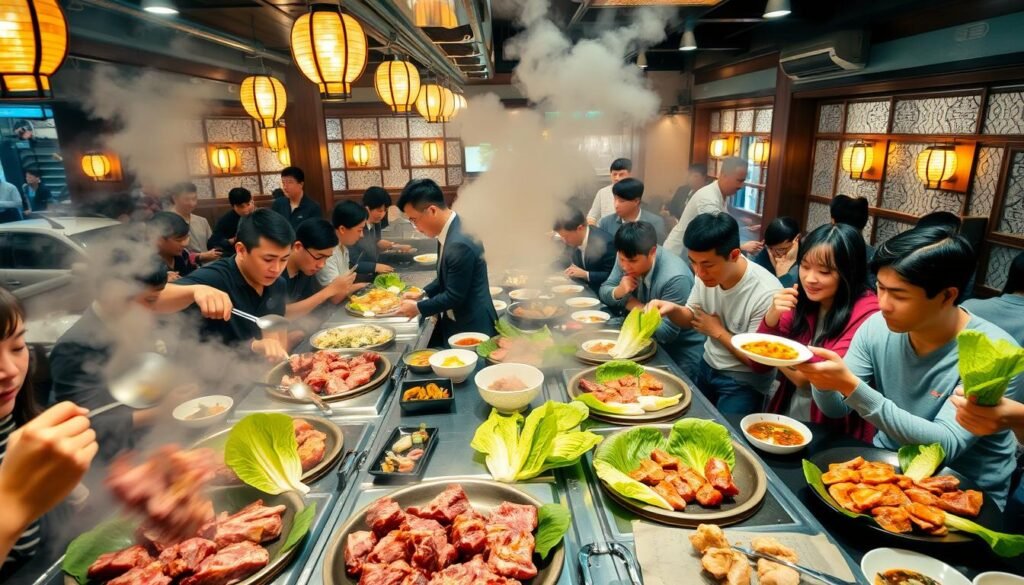
Understanding the BBQ Dining Culture
Korean BBQ is special because it combines tasty food with social time. You get marinated meats, veggies, and sauces. This way, everyone makes their meal just how they like it.
Essential Dishes to Try at Korean BBQ
You must try certain dishes at Korean BBQ. Don’t skip Samgyeopsal (pork belly) and bulgogi (beef). With banchan sides like kimchi, you’re in for a flavor adventure.
Best Korean BBQ Restaurants in the U.S.
Korean BBQ is getting big in the USA. You can enjoy it in places like Los Angeles or New York. Cities have many spots that mix great taste with tradition. This makes Korean BBQ loved nationwide.
Traditional Korean Soups and Stews
Korean soups and stews bring comfort to the table. These dishes are key in Korea’s food scene. They offer warmth and a burst of flavor. Let’s check out some must-try dishes!
Kimchi Jjigae: A Heartwarming Kimchi Stew
If you’re a fan of kimchi’s bold taste, you’ll love kimchi jjigae. This stew is a flavor bomb. It’s made with kimchi, pork, tofu, and sometimes tuna. The ingredients are slow-cooked to create a spicy, savory mix. It’s like getting a warm hug, perfect for cold nights!
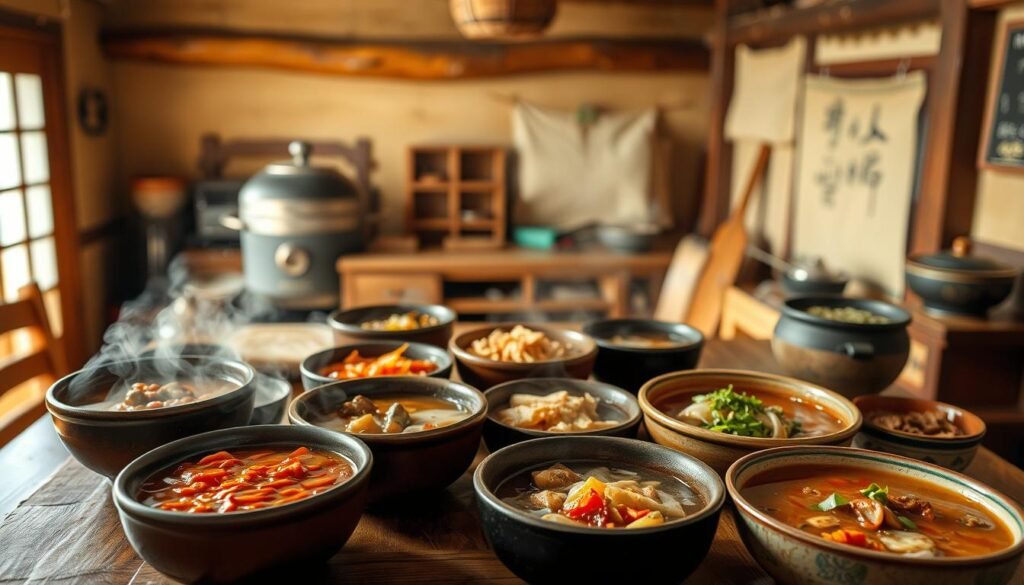
Sundubu Jjigae: Silken Tofu Stew Basics
Now, let’s discuss sundubu jjigae. This stew is famous for its spicy broth and silken tofu. The tofu pairs with clams, shrimp, and pork for a rich taste. Often served in a hot stone pot, it’s a treat for the senses.
Galbitang: Rib Soup for the Soul
Galbitang is a soothing rib soup. Simmering beef short ribs for hours makes it. This creates a clear broth that’s deeply beefy. With green onions and a side of rice, it’s fulfilling. It’s perfect for when you need comforting or are feeling sick.
Street Food Favorites
Korean street food is all about variety and taste. Everywhere you go, from busy markets in Seoul to local Korean towns in the U.S., you’ll find these snacks. They’re something you must try!
Gimbap: Korean Rice Rolls on the Go
Gimbap rolls are a big part of Korean street food. Picture this: rice with tasty fillings like pickled radish, spinach, and carrots. This is all wrapped in seaweed. It’s not just a snack; it’s a whole meal! If you need something quick and healthy that tastes great, gimbap is perfect.
Hotteok: Sweet Syrup-Filled Pancakes
Craving something sweet? Try hotteok pancakes! They’re crispy outside and filled with a sweet syrup and nuts inside. These hotteok pancakes are a dream for anyone with a sweet tooth. Just one bite will make you very happy.
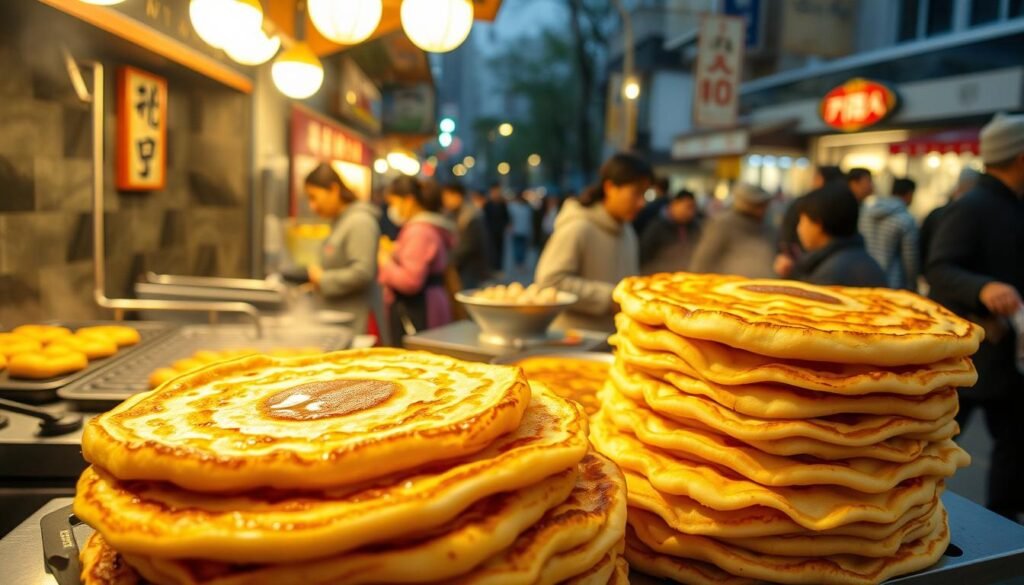
Odeng: Savory Fish Cake Sticks
You can’t miss out on odeng fish cakes when exploring Korean street food. These savory fish cakes come on sticks and are served with a tasty broth. The broth warms you up, making odeng great for cold days. Their soft texture and flavor make odeng a cozy food favorite.
Regional Variations in Korean Food
In Korea, each place offers unique tastes that are a treat. Jeolla-do is known for luxurious meals. And the food of Northern and Southern Korea offers exciting contrasts.
Exploring the Flavors of Jeolla-do
Jeolla-do is celebrated as Korea’s food heart, blessed with fertile lands. Its dishes feature various banchan (side dishes). Imagine being in a lively market full of colors and smells. That’s the essence of Jeolla-do—vibrant and diverse.
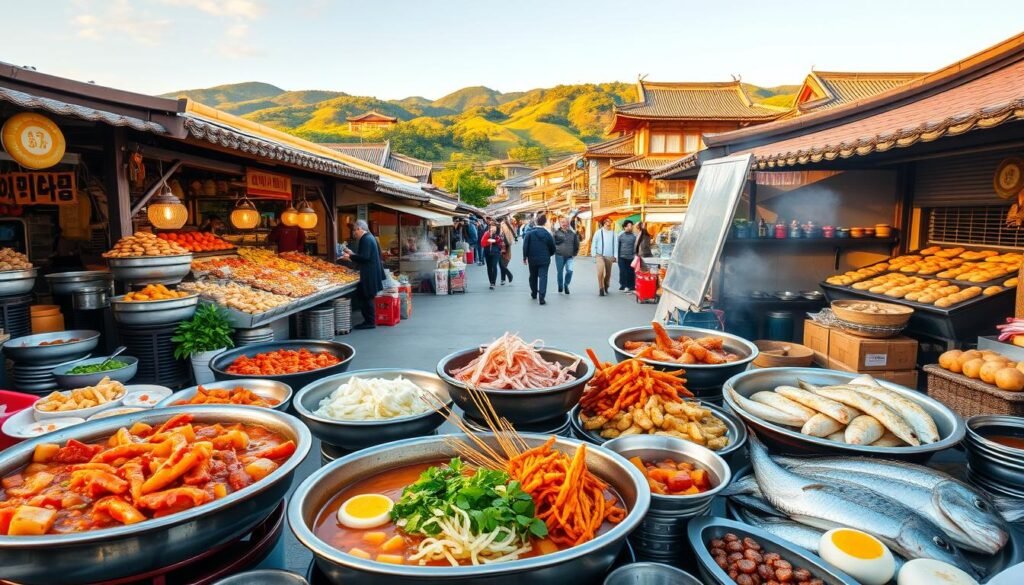
Here, bold spices make every meal memorable. You might enjoy Heotjesabab (mixed rice) or Kongnamul Gukbap (bean sprout soup). These dishes show how great the food in this region is.
Northern vs. Southern Korean Specialties
In Northern South Korean food versus Southern Korean cuisine, there’s a clear difference. Northern dishes often have gentler tastes. They highlight the freshness of ingredients. A dish like Naengmyeon (cold buckwheat noodles) is perfect for warm weather, with its light flavor.
Meanwhile, Southern Korean food loves strong, spicy tastes. It includes a lot of seafood. Dishes like Jogae Tang (clam soup) and Jeonbok Juk (abalone porridge) showcase the South’s love for flavor.
| Aspect | Northern South Korean Food | Southern Korean Cuisine | Jeolla-do Flavors |
|---|---|---|---|
| Flavor Profile | Milder, focusing on ingredient quality | Bolder, spicier | Diverse, with many side dishes |
| Main Ingredients | Noodles, cold dishes | Seafood, spicy elements | Varied, rich use of vegetables and spices |
| Iconic Dishes | Naengmyeon | Jogae Tang, Jeonbok Juk | Heotjesabab, Kongnamul Gukbap |
Vegetarian and Vegan Korean Options
Korean food has lots of vegetarian options. It’s full of vibrant flavors and different ingredients. Let’s learn about vegan Korean food and get excited about plant-based cooking!
Plant-Based Versions of Traditional Dishes
Making vegetarian and vegan Korean dishes is not hard. Picture a vegan bibimbap full of veggies and tofu. Or a vegan bulgogi with seitan. Tofu, mushrooms, and sweet potatoes can mimic the flavors and textures of Korean meals.
Popular Vegan-Friendly Korean Ingredients
Korean cooking uses many vegan ingredients. Doenjang, a soybean paste, adds depth to dishes. Gochujang, a spicy chili paste, brings heat and sweetness. Fresh and pickled veggies are also key. They make dishes like kimchi and salads tasty.
Exploring vegetarian Korean cooking lets you try and create new meals. Have fun finding and making different vegan dishes!

Korean Desserts You Should Try
Exploring Korean desserts is like going on an adventure. It’s filled with surprises in taste and texture. These desserts are a great ending to any meal. They offer everything from cool refreshments to sweet, rich flavors. Let’s look at some Korean sweets you might not know but should try.
Bingsu: Shaved Ice Treats
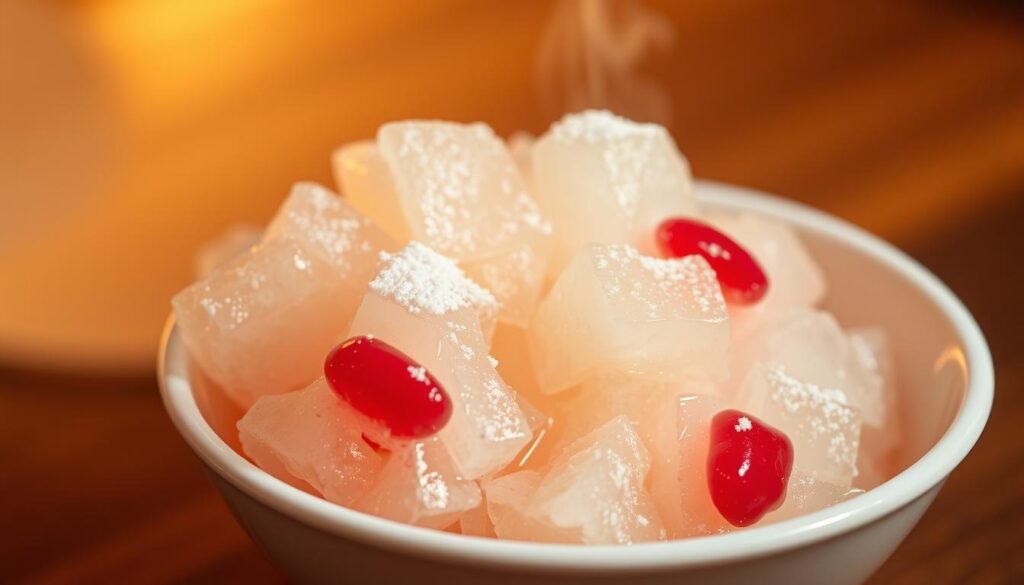
Bingsu is a refreshing treat perfect for hot days. Picture fine shaved ice piled high. It’s topped with tasty things like fresh fruit, condensed milk, and sometimes red bean paste. Every bite melts in your mouth. It mixes flavors in a way that’s both cool and fulfilling.
Tteok: Traditional Korean Rice Cakes
Tteok rice cakes are a key part of Korean sweets. They come in many shapes and each has its own flavor. Usually, they’re a bit sweet and chewy. Tteok may have sesame seeds, sweet fillings, or beans. They’re great for celebrations or just a snack with tea. And they never let you down.
Hotteok: Sweet Pancakes to Satisfy Your Cravings
Hotteok sweet pancakes are a cold-weather favorite. They’re fried until golden and filled with cinnamon, sugar, and nuts. The outside is crispy. Inside, they’re soft and full of sweet flavours. Hotteok is a treat you’ll want over and over!
Where to Find the Best Korean Food in the U.S.
If you’re craving Korean food in the US, you’re in luck! The United States has great spots for authentic Korean food. Whether you want BBQ, kimchi jjigae, or hotteok, you’ll find it here!
Top Cities for Authentic Korean Cuisine
Certain U.S. cities are known for their Korean food. Los Angeles has a Koreatown full of Korean BBQ places, cafes, and top restaurants. Here, you can enjoy dishes like bibimbap and tteokbokki. New York’s Koreatown in Manhattan offers a wide array of Korean eats. And Atlanta’s Korean restaurants mix traditional flavors with modern twists.
Must-Visit Restaurants and Food Festivals
Los Angeles and New York celebrate Korean food with annual festivals. These events showcase Korean cuisine with cooking shows, food booths, and live music. Must-try places include Kang Ho Dong Baekjeong in LA for BBQ. Or try Cote in New York for a high-end meal. These choices highlight why the U.S. is amazing for Korean food lovers.